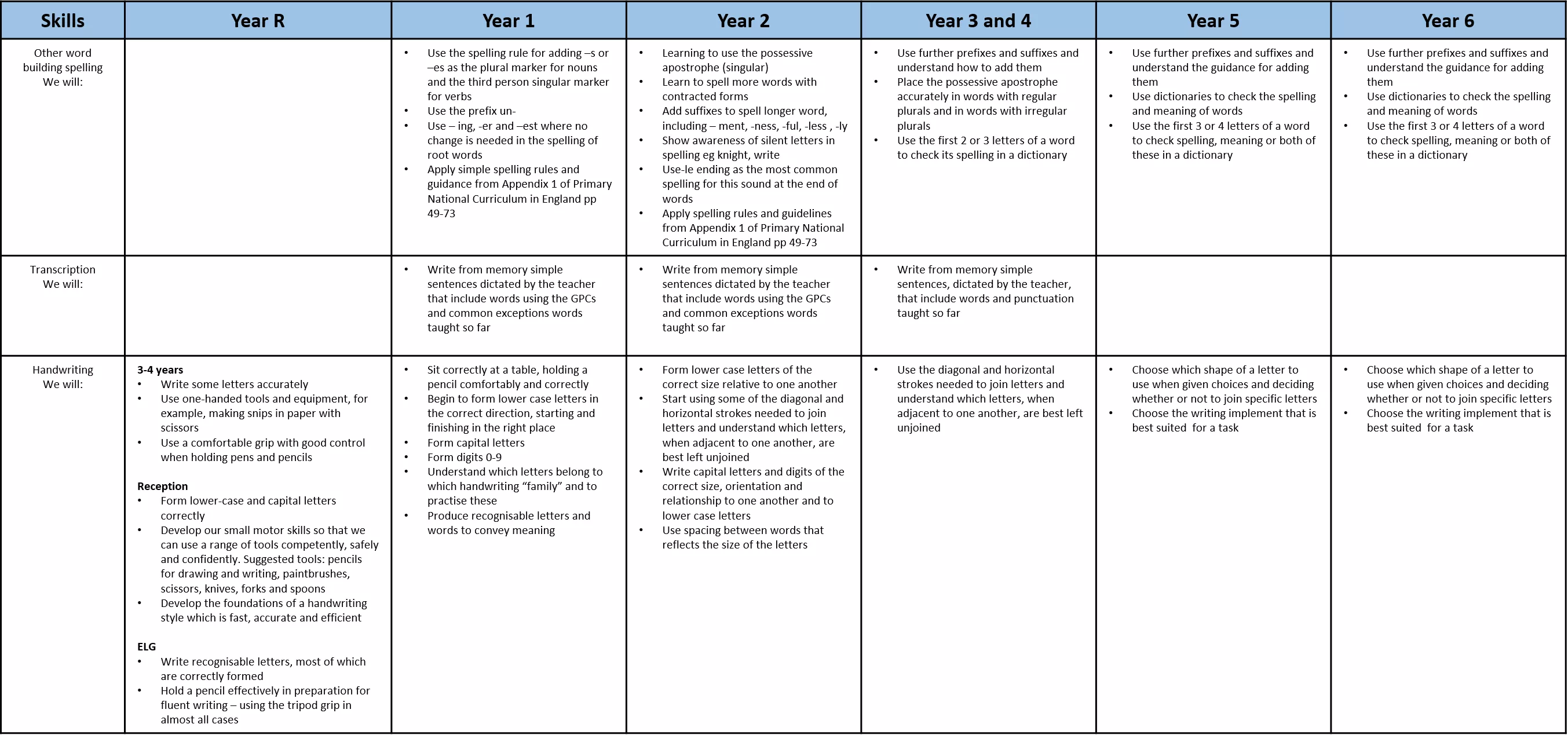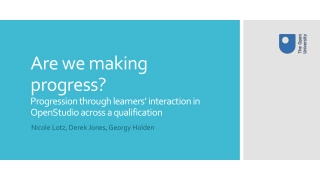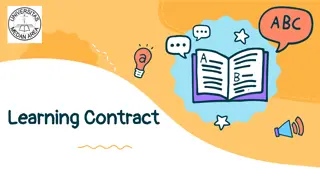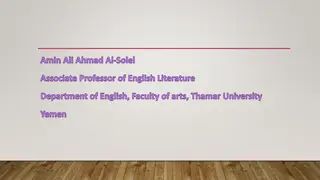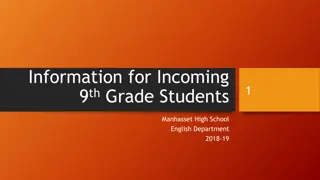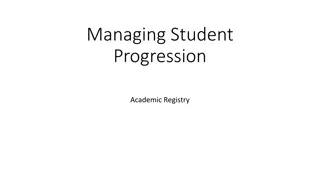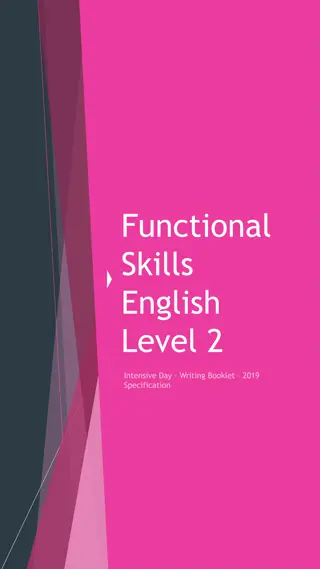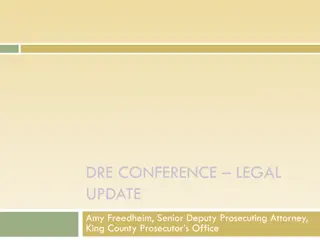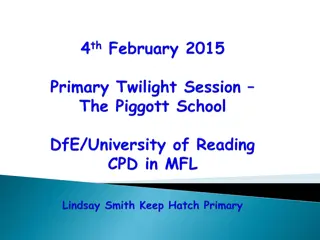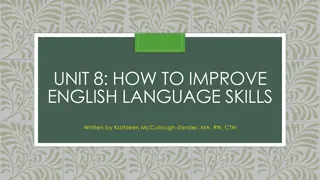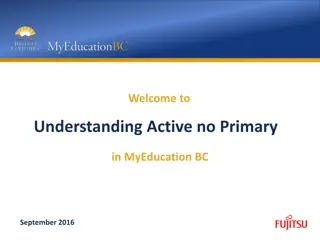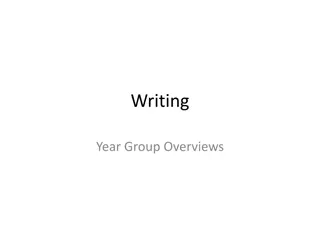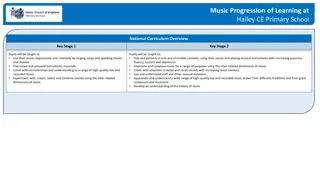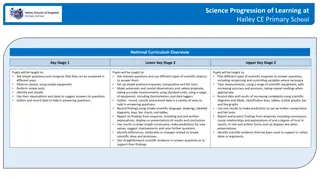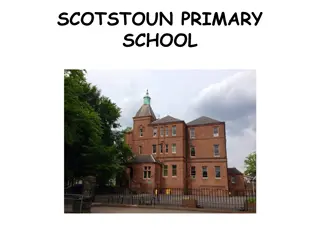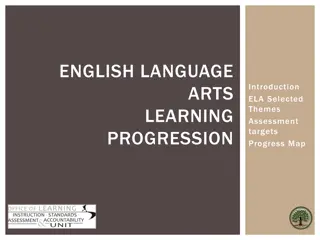English Writing Skills Progression at Hailey CE Primary School
Learn about the progression of English writing skills at Hailey CE Primary School, covering different topics and skills from Reception to Year 6. Students develop phonetic and whole-word spelling abilities, progressing from basic letter recognition to more complex words and homophones. The curriculum emphasizes phoneme/grapheme correspondence, spelling accuracy, handwriting fluency, and morphology and etymology in spelling. Through engaging topics and activities, students enhance their writing proficiency and literacy skills.
Download Presentation

Please find below an Image/Link to download the presentation.
The content on the website is provided AS IS for your information and personal use only. It may not be sold, licensed, or shared on other websites without obtaining consent from the author. Download presentation by click this link. If you encounter any issues during the download, it is possible that the publisher has removed the file from their server.
E N D
Presentation Transcript
English Writing Skills Progression of Learning at Hailey CE Primary School Skills Year R Year 1 Year 2 Year 3 and 4 Year 5 Year 6 Topic Me & My Community Once Upon a Time Starry Night Dangerous Dinosaurs Sunshine & Sunflowers Big Wide World Let s Explore Long Ago Marvellous Machines Ready Steady Grow Animal Safari On the Beach Moon Zoom Bright Lights, Big City Movers & Shakers Superheroes Land Ahoy! Beat Band Boogie! School Days The Enchanted Woodland Towers, Tunnels & Turrets Dinosaur Planet Muck, Mess & Mixtures Wriggle & Crawl Moon Zoom Bright Lights, Big City Movers & Shakers Superheroes Land Ahoy! Beat Band Boogie! School Days The Enchanted Woodland Towers, Tunnels & Turrets Dinosaur Planet Muck, Mess & Mixtures Wriggle & Crawl Blue Abyss Tremors Mighty Metals Through the Ages Gods & Mortals Predator! Scrumdiddlyumptious! Flow 1066 Potions Burps, Bottoms & Bile I am Warrior! A Child s War Maafa Stargazers Blood Heart Allotment Gallery Rebels Hola Mexico! Frozen Kingdoms Pharaohs Scream Machine ID Darwin s Delights A Child s War Maafa Stargazers Blood Heart Allotment Gallery Rebels Hola Mexico! Frozen Kingdoms Pharaohs Scream Machine ID Darwin s Delights Phonic & whole word spelling We will: 3-4 years Use some of our print and letter knowledge in our early writing. For example: writing a pretend shopping list that starts at the top of the page; writing m for mummy Write some or all of our name Spell words containing each of the 40+ phonemes taught Spell common exception words Spell the days of the week Name the letters of the alphabet in order Use letter names to distinguish between alternative spellings of the same sound Spell words with simple phoneme/grapheme correspondence accurately e.g. cat, dog, red Make phonetically plausible attempts at writing longer words using dominant phonemes and common grapheme representations Segment spoken words into phonemes and represent these by graphemes, spelling many correctly Learn new ways of spelling phonemes for which one or more spellings are already known and learn some words with each spelling, including a few common homophones Learn to spell common exception words Distinguish between homophones and near homophones Spell further homophones Spell words that are often misspelt (see Appendix 1 of Primary National Curriculum in England pp 49-73) Spell some words with silent letters Continue to distinguish between homophones and other words which are often confused Use knowledge of morphology and etymology in spelling and understand that the spelling of some words needs to be learnt specifically, as listed in Appendix 1 of Primary National Curriculum in England pp 49-73 Spell some words with silent letters Continue to distinguish between homophones and other words which are often confused Use knowledge of morphology and etymology in spelling and understand that the spelling of some words needs to be learnt specifically, as listed in Appendix 1 of Primary National Curriculum in England pp 49-73 Reception Spell words by identifying the sounds and then writing the sound with letter/s. Write short sentences with words with known sound-letter correspondences using a capital letter and full stop ELG Spell words by identifying sounds in them and representing the sounds with a letter or letters Write simple phrases and sentences that can be read by others Hold a pencil effectively in preparation for fluent writing using the tripod grip in almost all cases
Skills Year R Year 1 Year 2 Year 3 and 4 Year 5 Year 6 Other word building spelling We will: Use the spelling rule for adding s or es as the plural marker for nouns and the third person singular marker for verbs Use the prefix un- Use ing, -er and est where no change is needed in the spelling of root words Apply simple spelling rules and guidance from Appendix 1 of Primary National Curriculum in England pp 49-73 Learning to use the possessive apostrophe (singular) Learn to spell more words with contracted forms Add suffixes to spell longer word, including ment, -ness, -ful, -less , -ly Show awareness of silent letters in spelling eg knight, write Use-le ending as the most common spelling for this sound at the end of words Apply spelling rules and guidelines from Appendix 1 of Primary National Curriculum in England pp 49-73 Use further prefixes and suffixes and understand how to add them Place the possessive apostrophe accurately in words with regular plurals and in words with irregular plurals Use the first 2 or 3 letters of a word to check its spelling in a dictionary Use further prefixes and suffixes and understand the guidance for adding them Use dictionaries to check the spelling and meaning of words Use the first 3 or 4 letters of a word to check spelling, meaning or both of these in a dictionary Use further prefixes and suffixes and understand the guidance for adding them Use dictionaries to check the spelling and meaning of words Use the first 3 or 4 letters of a word to check spelling, meaning or both of these in a dictionary Transcription We will: Write from memory simple sentences dictated by the teacher that include words using the GPCs and common exceptions words taught so far Write from memory simple sentences dictated by the teacher that include words using the GPCs and common exceptions words taught so far Write from memory simple sentences, dictated by the teacher, that include words and punctuation taught so far Handwriting We will: 3-4 years Sit correctly at a table, holding a pencil comfortably and correctly Begin to form lower case letters in the correct direction, starting and finishing in the right place Form capital letters Form digits 0-9 Understand which letters belong to which handwriting family and to practise these Produce recognisable letters and words to convey meaning Form lower case letters of the correct size relative to one another Start using some of the diagonal and horizontal strokes needed to join letters and understand which letters, when adjacent to one another, are best left unjoined Write capital letters and digits of the correct size, orientation and relationship to one another and to lower case letters Use spacing between words that reflects the size of the letters Use the diagonal and horizontal strokes needed to join letters and understand which letters, when adjacent to one another, are best left unjoined Choose which shape of a letter to use when given choices and deciding whether or not to join specific letters Choose the writing implement that is best suited for a task Choose which shape of a letter to use when given choices and deciding whether or not to join specific letters Choose the writing implement that is best suited for a task Write some letters accurately Use one-handed tools and equipment, for example, making snips in paper with scissors Use a comfortable grip with good control when holding pens and pencils Reception Form lower-case and capital letters correctly Develop our small motor skills so that we can use a range of tools competently, safely and confidently. Suggested tools: pencils for drawing and writing, paintbrushes, scissors, knives, forks and spoons Develop the foundations of a handwriting style which is fast, accurate and efficient ELG Write recognisable letters, most of which are correctly formed Hold a pencil effectively in preparation for fluent writing using the tripod grip in almost all cases
Skills Year R Year 1 Year 2 Year 3 and 4 Year 5 Year 6 Contexts for Writing We will: 3-4 years Write narratives about personal experiences and those of others (real and fictional) Write about real events Write poetry Write for different purposes Write narratives about personal experiences and those of others (real and fictional) Write about real events Write poetry Write for different purposes Discuss writing similar to that which we are planning to write in order to understand and learn from its structure, vocabulary and grammar Identify the audience for and purpose of the writing, selecting the appropriate form and using other similar writing as models for our own In writing narratives, consider how authors have developed characters and settings in what pupils have read, listened to or seen performed Identify the audience for and purpose of the writing, selecting the appropriate form and using other similar writing as models for our own In writing narratives, consider how authors have developed characters and settings in what pupils have read, listened to or seen performed Reception Write short sentences with words with known sound-letter correspondences using a capital letter and full stop ELG Write simple phrases and sentences that can be read by others. Planning Writing We will: Reception Articulate our ideas and thoughts in well-formed sentences (C&L) Connect one idea or action to another using a range of connectives (C&L) Say out loud what we are going to write about Compose a sentence orally before writing it Plan or say out loud what we are going to write about Discuss and record ideas Compose and rehearse sentences orally (including dialogue), progressively building a varied and rich vocabulary and an increasing range of sentence structures Note and develop initial ideas, drawing on reading and research where necessary Note and develop initial ideas, drawing on reading and research where necessary Drafting Writing We will: Reception Articulate our ideas and thoughts in well-formed sentences. (C&L) Connect one idea or action to another using a range of connectives. (C&L) Sequence sentences to form short narratives Write down ideas and/or key words, including new vocabulary Encapsulate what we want to say, sentence by sentence Organise paragraphs around a theme In narratives, create settings, characters and plot In non-narrative material, use simple organisational devices (headings and subheadings) Select appropriate grammar and vocabulary, understanding how such choices can change and enhance meaning In narratives, describe settings, characters and atmosphere and integrate dialogue to convey character and advance the action Precis longer passages Use a wide range of devices to build cohesion within and across paragraphs Use further organisational and presentational devices to structure text and to guide the reader Select appropriate grammar and vocabulary, understanding how such choices can change and enhance meaning In narratives, describe settings, characters and atmosphere and integrate dialogue to convey character and advance the action Precis longer passages Use a wide range of devices to build cohesion within and across paragraphs Use further organisational and presentational devices to structure text and to guide the reader Editing Writing We will: 3-4 years Re-read what we have written to check that it makes sense Discuss what we have written with the teacher or other pupils Evaluate our writing with the teacher and other pupils Re-read to check that our writing mases sense and that verbs to indicate time are used correctly and consistently, including verbs in the continuous forms Assess the effectives of our own and others writing and suggest improvements Propose changes to grammar and vocabulary to improve consistency, including the accurate use of pronouns in sentences Proofread for spelling and punctuation errors Assess the effectives of our own and others writing Propose changes to vocabulary, grammar and punctuation to enhance effects and clarify meaning Ensure the consistent and correct use of tense throughout the piece of writing Ensure correct subject and verb agreement when using singular and plural, distinguishing between the language of speech & writing and choosing the appropriate register Proofread for spelling and punctuation errors Assess the effectives of our own and others writing Propose changes to vocabulary, grammar and punctuation to enhance effects and clarify meaning Ensure the consistent and correct use of tense throughout the piece of writing Ensure correct subject and verb agreement when using singular and plural, distinguishing between the language of speech & writing and choosing the appropriate register Proofread for spelling and punctuation errors Reception Read what we have written to check that it makes sense ELG
Skills Year R Year 1 Year 2 Year 3 and 4 Year 5 Year 6 Performing Writing We will: Read our writing aloud clearly enough to be heard by our peers and our teacher Read aloud what we have written with appropriate intonation to make the meaning clear Read our own writing aloud, to a group or the whole class, using appropriate intonation and controlling the tone and volume so that the meaning is clear Perform our own composition, using appropriate intonation, volume and movement so that meaning is clear Perform our own composition, using appropriate intonation, volume and movement so that meaning is clear Vocabulary We will: Leave spaces between words Join words and joining clauses using and Use familiar adjectives to add detail e.g. red apple, bad wolf Use expanded noun phrases to describe and specify Attempt some varied vocab and use some varied sentence openings e.g. time connectives Extend the range of sentences with more than one clause by using a wider range of conjunction, including when, if, because, although Choose nouns or pronouns appropriately for clarity and cohesion and to avoid repetition Use a thesaurus Use expanded noun phrases to convey complicated information concisely Use modal verbs or adverbs to indicate degrees of possibility Use a thesaurus Use expanded noun phrases to convey complicated information concisely Use modal verbs or adverbs to indicate degrees of possibility Grammar We will: Use regular plural noun suffixes (-s, - es) Use verb suffixes where the root word is unchanged Use the un prefix to change meaning of adjectives/adverbs Combine words to make sentences, including using and sequencing sentences to form short narratives Separate words with spaces Use sentence demarcation (.!?) Use capital letters for names and pronoun I Use coordination (using or, and, or but) Use commas in lists Use sentences with different forms: statement, question, exclamation, command Use subordinate (using when, if, that, or because) Use apostrophes for omission and singular possession Use the present and past tenses correctly and consistently including adverbs, adjectives to add interest Use some features of written Standard English Learn how to use selected grammar for Year 2 Use and understand grammatical terminology when discussing writing Use to present perfect form of verbs in contrast to the past tense Form nouns using prefixes Use the correct form of a or an Use word families based on common words (solve, solution, dissolve, insoluble) Use fronted adverbials Use conjunctions, adverbs and prepositions to express time and clause Learn, use and understand the grammatical terminology in English Appendix 2 (from Primary National Curriculum in England) accurately and appropriately when discussing our writing and reading Use the perfect form of verbs to mark relationships of time and cause Use relative clauses beginning with who, which, when, whose, that or with an implied (ie omitted) relative pronoun Convert nouns or adjectives into verbs Use verb prefixes Use devices to build cohesion, including adverbials of time, place and number Recognise vocabulary and structures that are appropriate for formal speech and writing, including subjunctive forms Use passive verbs to affect the presentation of information in a sentence Use the perfect form of verbs to mark relationships of time and clause Understand and use differences in information and formal language Understand synonyms and antonyms Use further cohesive devices such as grammatical connections and adverbials Use ellipsis Punctuation We will: Begin to punctuate sentences using a capital letter and a full stop, question mark or exclamation mark Use a capital letter for names of people, places, the days of the week, and the personal pronoun I Develop understanding by learning how to use familiar and new punctuation correctly Use full stops and capital letters and question marks use sentence demarcation CL . ? Use exclamation marks and commas in a list. Use apostrophes for contracted form and for possession Use commas after fronted adverbials Indicate possession by using the possessive apostrophe with singular and plural nouns Use and punctuate direct speech (including punctuation within and surrounding inverted commas) Use commas to clarify meaning or avoid ambiguity in writing Use brackets, dashes or commas to indicate parenthesis Use hyphens to avoid ambiguity Use semicolons, colons or dashes to mark boundaries between independent clauses Use a colon to introduce a list punctuating bullet points consistently
Skills Year R Year 1 Year 2 Year 3 and 4 Year 5 Year 6 Grammatical Terminology We will learn the meaning of: Letter Capital letter Word Sentence Full stop Letter Capital letter Word Singular Plural Sentence Punctuation Full stop Question mark Exclamation mark Noun Noun phrase statement Question Exclamation Command Compound Adjective Verb Suffix Adverb Tense (past, present) Apostrophe Comma Adverb Preposition Conjunction Word family Prefix Clause Subordinate clause Direct speech Consonant Vowel Inverted commas (or speech marks) Determiner (Year 4) Pronoun (Year 4) Possessive pronoun adverbial (Year 4) Modal verb Relative pronoun Relative clause Parenthesis Bracket Dash Cohesion Ambiguity Subject Object Active Passive Synonym Antonym Ellipsis Hyphen Colon Semi-colon Bullet Points








